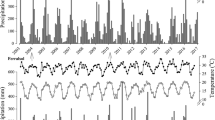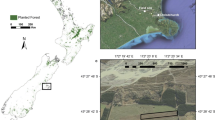Abstract
Clonal forestry is a reality in the southeastern United States due to improvements in somatic embryogenesis of Pinus taeda L. Differences in below-ground carbon (C) allocation between individual genotypes could alter C sequestration and cycling in these clonal plantations. Biomass partitioning may vary between clones and in response to management practices, like fertilization. Our objective was to quantify differences in biomass partitioning due to fertilization in contrasting clones of P. taeda produced from the same full-sib cross. A two (clone)-by-two (fertilizer)-by-four (sequential harvest) factorial randomized complete block design was replicated eight times in a greenhouse for 4 months. Trees were destructively harvested monthly following fertilizer application, so changes in biomass partitioning could be determined. Both clones responded to fertilizer with a short-term reduction in root:shoot ratio and increase in foliar biomass. These changes were ephemeral, returning to control levels within 4 months. Fertilizer responses in below-ground partitioning were due to allometric differences in one clone, but were only attributable to altered rates of development in the other. Ephemeral changes in biomass partitioning in response to fertilizer application were consistent with a theory of short-term physiological response to increased nutrient availability fueling long-term fertilizer growth responses.







Similar content being viewed by others
References
Adegbidi HG, Jokela EJ, Comerford NB, Barros NF (2002) Biomass development for intensively managed loblolly pine plantations growing on Spodosols in the southeastern USA. For Ecol Manag 167:91–102
Albaugh TJ, Allen HL, Dougherty PM, Kress LW, King JS (1998) Leaf area and above- and belowground growth responses of loblolly pine to nutrient and water additions. For Sci 44:317–328
Albaugh TJ, Allen HL, Dougherty PM, Johnsen KH (2004) Long term growth responses of loblolly pine to optimal nutrient and water resource availability. For Ecol Manag 192:3–19
Albaugh TJ, Allen HL, Kress LW (2006) Root and stem partitioning of Pinus taeda. Trees Struct Funct 20:176–185
Baltunis BS, Huber DA, White TL, Goldfarb B, Stelzer HE (2007) Genetic gain from selection for rooting ability and early growth in vegetatively propagated clones of loblolly pine. Tree Genet Genomes 3:227–238
Barnes AD (2002) Effects of phenology, water availability and seed source on loblolly pine biomass partitioning and transpiration. Tree Physiol 22:733–740
Bitoki O (2008) Comparing early survival and growth of varietal and open-pollinated loblolly pine seedlings. VDOF For Res Rev 2008:4–5
Cannell MGR, Willett SC (1976) Shoot growth phenology, dry matter distribution and root:shoot ratios of provenances of Populus trichocarpa, Picea sitchensis and Pinus contorta growing in Scotland. Silvae Genetica 25:49–59
Colbert SR, Jokela EJ, Neary DG (1990) Effects of annual fertilization and sustained weed-control on dry-matter partitioning, leaf-area, and growth efficiency of juvenile loblolly and slash pine. For Sci 36:995–1014
Coyle DR, Coleman MD (2005) Forest production responses to irrigation and fertilization are not explained by shifts in allocation. For Ecol Manag 208:137–152
Coyle DR, Coleman MD, Aubrey DP (2008) Above- and below-ground biomass accumulation, production, and distribution of sweetgum and loblolly pine grown with irrigation and fertilization. Can J For Res 38:1335–1348
Dougherty D (2007) Improved returns on forestlands: a financial analysis of MCP and varietal seedlings on private land in the southeastern United States. For Landowner 66:15–18
Drew AP, Ledig FT (1980) Episodic growth and relative shoot–root balance in loblolly-pine seedlings. Ann Bot 45:143–148
Edwards GS, Friend AL, Oneill EG, Tomlinson PT (1992) Seasonal patterns of biomass accumulation and carbon allocation in Pinus taeda seedlings exposed to ozone, acidic precipitation, and reduced soil Mg. Can J For Res 22:640–646
Fox TR, Allen HL, Albaugh TJ, Rubilar R, Carlson CA (2007a) Tree nutrition and forest fertilization of pine plantations in the southern United States. South J Appl For 31:5–11
Fox TR, Jokela EJ, Allen HL (2007b) The development of pine plantation silviculture in the southern United States. J For 105:337–347
Gebauer RLE, Reynolds JF, Strain BR (1996) Allometric relations and growth in Pinus taeda: the effect of elevated CO2 and changing N availability. New Phytol 134:85–93
Gough CM, Seiler JR (2004) Belowground carbon dynamics in loblolly pine (Pinus taeda) immediately following diammonium phosphate fertilization. Tree Physiol 24:845–851
Gough CM, Seiler JR, Maier CA (2004) Short-term effects of fertilization on loblolly pine (Pinus taeda L.) physiology. Plant Cell Environ 27:876–886
Green TH, Mitchell RJ, Gjerstad DH (1994) Effects of nitrogen on the response of loblolly-pine to drought. 2. Biomass allocation and C–N balance. New Phytol 128:145–152
Griffin KL, Winner WE, Strain BR (1995) Growth and dry-matter partitioning in loblolly and ponderosa pine-seedlings in response to carbon and nitrogen availability. New Phytol 129:547–556
Iivonen S, Rikala R, Vapaavuori E (2001) Seasonal root growth of Scots pine seedlings in relation to shoot phenology, carbohydrate status, and nutrient supply. Can J For Res 31:1569–1578
Jokela EJ, Martin TA (2000) Effects of ontogeny and soil nutrient supply on production, allocation, and leaf area efficiency in loblolly and slash pine stands. Can J For Res 30:1511–1524
Jokela EJ, Dougherty PM, Martin TA (2004) Production dynamics of intensively managed loblolly pine stands in the southern United States: a synthesis of seven long-term experiments. For Ecol Manag 192:117–130
King JS, Albaugh TJ, Allen HL, Kress LW (1999) Stand-level allometry in Pinus taeda as affected by irrigation and fertilization. Tree Physiol 19:769–778
King NT, Seiler JR, Fox TR, Johnsen KH (2008) Post-fertilization physiology and growth performance of loblolly pine clones. Tree Physiol 28:703–711
Ledig FT, Bormann FH, Wenger KF (1970) The distribution of dry matter growth between shoots and roots in loblolly pine. Bot Gaz 131:349–359
Li BL, Allen HL, McKeand SE (1991) Nitrogen and family effects on biomass allocation of loblolly-pine seedlings. For Sci 37:271–283
Littell RC, Milliken GA, Stroup WW, Wolfinger RD, Schabenberger O (2006) SAS for mixed models, 2nd edn. SAS Institute Inc., Cary
Paul AD, Foster GS, Caldwell T, McRae J (1997) Trends in genetic and environmental parameters for height, diameter, and volume in a multilocation clonal study with loblolly pine. For Sci 43:87–98
Retzlaff WA, Handest JA, O’Malley DM, McKeand SE, Topa MA (2001) Whole-tree biomass and carbon allocation of juvenile trees of loblolly pine (Pinus taeda): influence of genetics and fertilization. Can J For Res 31:960–970
Roth BE, Jokela EJ, Martin TA, Huber DA, White TL (2007) Genotype × environment interactions in selected loblolly and slash pine plantations in the southeastern United States. For Ecol Manag 238:175–188
Samuelson LJ, Johnsen K, Stokes T (2004) Production, allocation, and stemwood growth efficiency of Pinus taeda L. stands in response to 6 years of intensive management. For Ecol Manag 192:59–70
Scarascia-Mugnozza GE, Ceulemans R, Heilman PE, Isebrands JG, Stettler RF, Hinckley TM (1997) Production physiology and morphology of Populus species and their hybrids grown under short rotation. 2. Biomass components and harvest index of hybrid and parental species clones. Can J For Res 27:285–294
Stelzer HE, Goldfarb B (1997) Implementing clonal forestry in the southeastern United States: SRIEG satellite workshop summary remarks. Can J For Res 27:442–446
Swindel BF (1970) Some applications of the principles of conditional error. USDA Forest Service Research Paper SE-59. Southern Research Station, Asheville
Tyree MC, Seiler JR, Maier CA (2009a) Short-term impacts of nutrient manipulations on leaf gas exchange and biomass partitioning in contrasting 2-year-old Pinus taeda clones during seedling establishment. For Ecol Manag 257:1847–1858
Tyree MC, Seiler JR, Maier CA, Johnsen KH (2009b) Pinus taeda clones and soil nutrient availability: effects of soil organic matter incorporation and fertilization on biomass partitioning and leaf physiology. Tree Physiol 29:1117–1131
Whetten RW, Kellison R (2010) Research gap analysis for application of biotechnology to sustaining US forests. J For 108:193–201
Acknowledgments
We acknowledge Bonnie Stovall, Kelly Merkl, Matthew Seiler, and John Peterson for help with sample processing. Thanks to Chris Maier, Mike Aust, Amy Brunner, and several anonymous reviewers for providing useful criticism on this manuscript. We would also like to thank Jeff Wright and Phil Dougherty at ArborGen for providing the seedlings, and Kurt Johnsen and Pete Anderson of the USDA Forest Service for providing soil. Funding was provided by the NSF Center for Advanced Forestry Systems and the Forest Nutrition Cooperative.
Author information
Authors and Affiliations
Corresponding author
Additional information
Communicated by E. Priesack.
Rights and permissions
About this article
Cite this article
Stovall, J.P., Fox, T.R. & Seiler, J.R. Short-term changes in biomass partitioning of two full-sib clones of Pinus taeda L. under differing fertilizer regimes over 4 months. Trees 26, 951–961 (2012). https://doi.org/10.1007/s00468-011-0673-4
Received:
Revised:
Accepted:
Published:
Issue Date:
DOI: https://doi.org/10.1007/s00468-011-0673-4




